So you want to build a successful, profitable concessions and vending business?
You know exactly what to serve. You can picture the lines of excited customers. You can see yourself making a good living selling your delicious foods.
But the gap between here and there seems far. There’s so much to figure out, so much that goes into starting a new business and building it to a respectable income, and it seems like there’s so much risk in any approach.
This guide will answer all those questions and more. We’ve helped over 700 entrepreneurs and organizations make their concession dreams come true, and we’re excited to help you do the same.
We’ve got five proven secrets to success you’ve probably never heard to help you get there in this industry.
Here’s a quick overview and table of contents. You can skip to any section or come back later from this menu.
[SECRET #1] Understand the different types of expenses and control them well
[SECRET #2] Use the SPIFF method for the perfect + profitable menu
[SECRET #3] Leverage your vending, fairs, and festivals to drive extra revenue
[SECRET #4] Build your brand in a way that gets you into the best events
[SECRET #5] Plan your winter business strategy
[BONUS SECRET] Build your setup to multiply all of the above
This is no shallow list of tips. It’s long, it’s very serious at times, and we tell it like it is. This is the information you need and the things you need to take into account to be successful in this industry.
But read on and combine the secrets in this mega-guide with your natural talent, unique approach, and wonderful recipes and you’ve got everything you need to build the culinary business of your dreams!
In the theme of being brutally honest, let’s start with this well-known fact: the food industry can be a tricky one. You can have lots of sales but still not make it. This is especially common among brick-and-mortar restaurants; they’re packed but not profitable.
But why? What kills these companies?
Their costs associated with doing business.
You must control your expenses to be successful. You can’t ignore them or they’ll fly out of control, taking your profits with them.

In a panic, some people control their costs by cutting corners to the point that it decreases quality. That’s not what you want. The goal is to keep costs low and margins high without sacrificing quality.
But we’ve got a clever secret to help you control costs, by doing so in the right order: first reduce overhead, then control recurring, then one-time expenses.
Let’s break that down.
In the food trailer business, there are three basic types of costs that all other costs can be classified by:
Those are easy enough to understand, so what’s the problem?
People overestimate the financial impact of one-time costs but underestimate the impact of controllable recurring costs and overhead.
I know that sounds complex, but it’s actually quite simple. Let’s break it down.
One-time costs are just that, one time. It’s a quick slice: You pay it and you have whatever you bought. But overhead and recurring costs bleed slowly, bringing financial death by a thousand paper cuts.
Without a doubt, be prudent and budget-conscious in spending on those one-time costs. But don’t skimp out on legible signage that encourages sales just to throw that “savings” away in food waste, which we’ll talk about in a bit.
Let’s start with the giant, silent profitability killer: overhead.
The big catch with overhead is the permanence of it: you pay those bills no matter how many shows you do, how many plates you sell, or how many customers you have. Even if you didn’t use your truck or trailer a single time that month, you still pay your overhead.
The largest overhead expense for most mobile food vendors is likely your food truck or concession trailer payment.
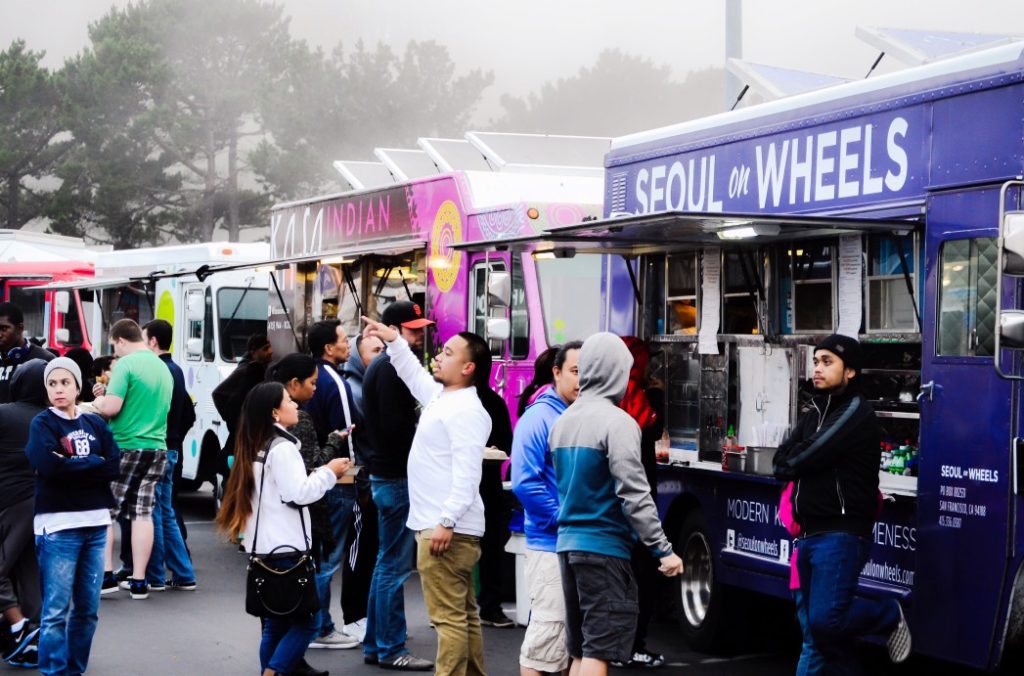
This is often treated as a necessary evil, but it actually has a simple solution: buy the best trailer you can afford based on what you actually need right now.
We know this is a bit unusual for a food trailer manufacturer to say, but it’s the truth: we want you to be successful, and we have a track-record of that success.
We’ve talked to many people who envisioned high profits without taking into account the work required to get to that point. They bought $100,000 food trucks to run $10,000 in sales in a year because they only had time (or opportunity) for a few shows. That’s over ten years of payments (plus interest and insurance) with no profit, not to mention the recurring stress.
Now compare that to purchasing an OMG trailer for under $10,000. We can’t speak for other types of trailers, but we prove this: most expensive competitor food trailers and trucks have many used ones for sale because their owners abandoned the business.
But in six years and 700+ trailers, 97% of OMGs are still operated by their original owners. Their first OMG is paid in full. Some have purchased a second and third trailer as their business grew.

They stay in business, partially due to their extremely low overhead and their business pays for itself in a much faster timeframe. They have the time to figure out their menu, their labor, the best shows, and build a catering clientele because they’re not bleeding money every month (and can even store it in their garage or yard) in the meantime.
Many of these folks have gone on to build a fleet, open brick-and-mortar restaurants, and run big catering companies, but they keep their original OMG concession trailer because it’s a long-lasting workhorse adaptable to many different situations.
So we can say from experience, buy the most affordable concession trailer you can, as it greatly improves success rates.
And when January comes and shows slow down and Christmas party catering ends, you’ll be grateful for the low monthly payment (or no payment, since affordable trailers pay off quickly.)
Now let’s talk about what in the long run will most certainly be your biggest expense: food cost.
Technically recurring costs include labor and rental fees, but for many vendors working with small teams, the #1 recurring cost is food cost, both in sold food cost (food you sold to a customer) and pre-consumer food waste cost (food you prepped or thawed by didn’t sell).

The general industry pre-consumer food waste cost is about 12% of the total. But at events where you don’t have a giant walk-in cooler, walk-in freezer, and 50’ of temperature holding equipment, expect that to be higher if your menu isn’t structured correctly.
Overspending by just 50 cents per plate on controllable costs, multiplied by two events a month doing only 100 plates each, equals an extra $100 a month in profit you lost. Poorly managing food waste can easily add another 25 to 50 cents a plate, bringing you to $150-200 per month in lost profit. But remember: this is for 100 plates at a small event.
Multiply that number by more plates and more events and even more as your business grows and you can see that you will either lose thousands or even tens of thousands of dollars over the course of the year or you can put that money in the bank.
How do you manage your food costs by managing your menu? We’ll discuss that in detail in Secret #2.
Now let’s talk about one-time costs. This is usually where people concentrate on saving money and controlling costs.
They’ll buy paper plates and plastic silverware at Dollar General at a higher cost than buying in bulk, and then lament over buying a menu board. But that .05 for that 100 plate venue is $5.00. Ten shows at that minimum number and $50 would have paid for that first menu board.
It’s the recurring cost of what will become trash that bleeds the profits that would have paid for the things that elevate your business.
Let’s see how just $110 could make a difference in comfort and lead to additional sales.
Lighting fixtures are a one-time cost new vendors often shirk away from. Even if you mostly sell during daylight hours, come fall, sunset will get earlier and earlier.
Lucrative events may run until 9PM, there’s catered evening parties and weddings, and food trailer parks are open until after dark. You can’t count on being under a pole light.
If you don’t have any exterior lighting, you won’t be visible, you’ll look closed, and nobody will be able to read your menu.
We’ve seen entrepreneurs needlessly close up early over not being prepared so they can save money without taking into account the lost sales. You can always start with LED string lights and add to them as you grow.
How about a tent shade cover that will last for many set-ups? It provides protection from the sun, serves as a passing shower cover, and also serves as a convenient place to attach those light to!
Set a fan blowing behind you on a sweltering day and you’ll be much more comfortable than those cramped inside a very hot concession truck.
We’ve also found that having a fan blowing on a hot day where customers can feel it will encourage business.
These are examples of one-time costs where a little bit of money up-front can make a big difference in the long-run.
It’s not that you need expensive versions of those things, but that you should consider those items could be paid for out of the money you’re wasting on controllable expenditures.
Those recurring costs you didn’t manage will quickly surpass those high-return one-time costs, such as good signage, increased lighting, a quality menu board, and the setup to accept credit cards by an order of magnitude.
So, to summarize:
First: Keep your overhead costs low. These are the monthly (or weekly, quarterly, annually) expenses you pay no matter what. This gives you the time and flexibility to build your business at a pace that works for you, and acts as an insurance policy against potential problems.
Next: Carefully control your recurring expenses like show setups and labor, but especially food cost and food waste costs. These add up very quickly, especially when they’re relatively simple to reduce. You can also take advantage of cost savings gained from bulk buying.
Then: Be prudent with one-time expenses. You don’t need the fanciest everything and you don’t want a habit of impulsive purchases “for the business”. But useful one-time expenses are small in comparison to other costs and can yield big returns in the long run, without the long-running costs.
Next, let’s talk about the secrets to a menu that’s sure to be successful, no matter what your cuisine or price point is.
There’s a great deal to cover when it comes to menu and concept design. (But let’s be honest, menu planning is also the most fun of the startup process.)
As we said above, we’ve seen many trailers with many different menu concepts, and we’re put together some of the common threads that separates the big successes from those who struggle. We call this the SPIFF method, because it SPIFFs up your menu and your profits big time.
It works the same for any menu, it will keep you from making massive mistakes that could sink your company, and it can make your enterprise a seriously profitable one that you could go full-time with and have to hire people to keep up with the demand.
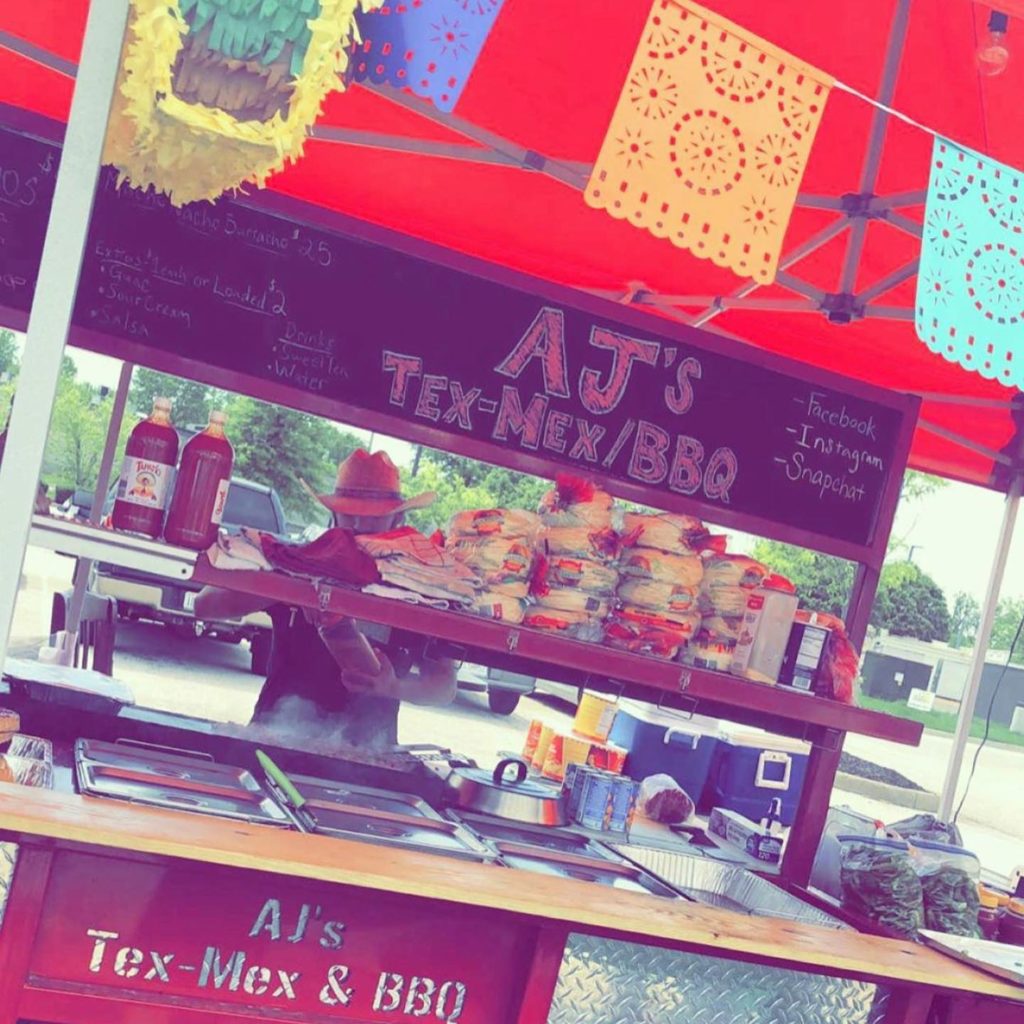
There’s five steps to SPIFFing your menu:
Pricing is often a cause of great stress for new concession trailer owners.
Should you be cheap, expensive, or in-between?
Should prices vary depending on where you sell?
Where can you get prices of competitors without aimlessly driving around looking for BBQ trailers?
Well, we’ll make it easy. When it comes to pricing, the premium ticket is always better, as it requires less foot traffic to make the same profit. (Or makes tons of profit if you have tons of foot traffic.)
But here’s the secret: the easiest way to go premium is by structuring your menu items right, not by always selling high-end foods. It’s not about selling a high-end product, but rather getting a premium average ticket price.
What’s that? Your average ticket price is the average amount a customer spends at your trailer. If you have five people in line to order, what will be the average amount they spend? Is it $5, $10, $20?
You want that number to be as high as possible. The lower the number, the more people you need for the same profit. This means you need a lot more people to see you in the first place, commonly referred to as foot traffic.
So how do you make the most money?
While you can sell $15 lobster rolls to drive up your average ticket price, you can also copy the fast food industry to maintain a higher ticket average and a higher margin: Sell add-ons and meal deals.
You see this in action with beverages at restaurants. They charge you $2.49 for a beverage that has a food cost of .05. The ticket average goes up and there’s greater margin on the drink to cover the higher food costs on the main plate.
In addition to drinks, up your average ticket price by offering a combination meal price that makes buyers feel like they got a deal. Think of those “supersize me”, “2 for $20”, and “combo meal deals” you see offered.

For example, many taco trucks struggle with being forced into a lower average ticket because of market expectations when it comes to single servings. If you’re competing with Taco Bell’s $1 menu, you need a ton of people walking by around lunch time to sell enough $1 tacos to make the same amount of money as someone selling $5 enchilada boxes.
Better yet, sell a taco box with three tacos, a side of beans or rice, a beverage, and a store-bought cookie for $10 as street food (or $14 at a ticketed fair) for a much higher average ticket, and much more profit-per-customer.
No lobsters required. (And if you’ve got a lobster to sell, stick him on tacos for an extra premium price.)
Now that you’re upselling high-margin drinks, sides, and cookies like a pro, let’s talk pricing.
Where should you price your food? Does a premium ticket also mean premium pricing?
Yes it does. Always charge the highest you can, otherwise you’re just leaving money on the table.
But that doesn’t mean be one of those people with $17 sandwiches at ticketed events (which is called supply-driven overpricing by people who like unnecessary big words) or $9 cupcakes (luxury pricing), unless you’re very, very dedicated to one of those models and finding ways to make it work.
It’s not about being expensive, you can be cheap and still use this technique. The secret is to sell at the top of your price ceiling.
Now, price ceiling may sound like one of those unnecessary big words we just made fun of, and it is a fancy economics pricing theory, but it makes sense in practice when you think about it.
It means to sell at the highest price customers are willing to comfortably pay at that venue.
Selling to the price ceiling isn’t about charging a high price, as the technique works from bargain-basement hotdogs to gourmet poke bowls. We’ll illustrate with an example that uses easy numbers for clarity.
Consider a water bottle sold at an event. The vendor buys 100 water bottles in bulk for 20 cents each and sells them at $1.20. Selling out equals $120 at the event from water in gross sales and $100 in net profit.

But why $1.20 and not any other amount? That’s just a number the vendor made up by adding $1 to the purchase price. Let’s imagine the vendor comes back the next month and sets up again, this time selling the identical water bottles for $1.50 each, again selling 100 bottles but now making $130 in net profit.
This is an extra $30 in profit with nothing done differently and no decrease in sales.
That’s because they’re selling nowhere near the price ceiling, that is, the price the same customers will easily pay for a product. Someone who will pay $1.20 will also pay $1.50, as the 30 cents doesn’t make enough of a difference to cause a drop in sales.
Now let’s say they do it again, this time selling them for $2 per bottle. They only sell 95 bottles now, losing 5 sales due to the price increase. But the majority of people who will pay $1.50 will also pay $2 as you’re still under the price ceiling.
Even with the drop in units sold, 95 x $2 is $190 in gross sales. The bottles still cost the same, so the profit is now $170 instead of the original $100 for the same event.
They make $70 extra for the exact same time, effort, and cost.
We even counted the extra five bottles as food waste in that example (accounting for their cost, despite unsold, since the water is sold in cases of 100 bottles), even though those bottles can simply be brought to the next event.
Technically, it’s less effort - that’s five fewer bottles to handle!
Now, let’s say they decide to raise the price to $4. The sales drop to only 20 bottles.
That’s only $80 total, and even accounting for the difference in sold food cost from 100 to 20, they took a significant drop in profit. That’s because they’ve significantly exceeded the price ceiling: 75 of the people who would pay $2 won’t pay $4, which has now crossed into a new threshold of pricing.
As you can see, this works well on cheap water bottles but it works even better on expensive foods. If someone will pay $8 for a meal, will they pay $8.50? $9? $10?
Perhaps...but probably not $20. And even if you see a small drop in demand, such as the five bottle drop in the example, this can sometimes still be a lot more profitable. The key is to find the sweet spot.
This is highly circumstantial as well, as water sold at major sports arenas can be $4 without much of a drop in demand (accompanied by loud complaining).
Beyond finding the ceiling to charge as much as you can within the market you’re selling to, remember your prices shouldn’t be set in stone.
What you sell on the street competes with restaurants and fast food, but if you’re at a ticketed event (such as a state fair where people paid $15 each just to get in), patrons are expecting higher prices on concessions, and your ceiling is likely much higher.

Considering you also paid a lot more to be vending there, raising your prices to the state fair’s price ceiling again makes sense. (Many of the biggest fairs actually set the prices for you. And they’re often almost unreasonably high.)
Keep experimenting with your prices until you’ve gone the highest your customers will happily pay, and build a cheat sheet for different types of events.
Looking for pricing inspiration? Here’s a hack for easy competitive menu research.
Go to Google Images and search for ____ (cuisine) food truck menu. For example: taco food truck menu, cajun food truck menu, BBQ food truck menu, and so on.
You can also try emitting “food” and swapping for “trailer”, but food truck will usually get the most results. Since they’re pictures of real street menus, you’ll be able to see what competitors and other vendors are charging to build your own price sheet from.
Note: this step is incredibly important for concessions and vending, but not so much for pre-paid catering.
This one is very important and very subtle. It’s something many food entrepreneurs miss, and it’s one of the easiest ways to sink a concessions company.
Here’s the secret: you need to keep your active ingredients count as low as possible.
This doesn’t mean you can’t have a lot of menu items or your items can only have a few ingredients or the ingredients have to be really simple, you just need to have a lot of crossover from one menu item to the next.
If you don’t, your starting food cost will be way too high and you’ll be throwing money away on food waste. These two factors will greatly impact your profitability.
The classic example of this is Tex-Mex food. Many Mexican restaurants have menus pages and pages long with hundreds of dishes, some with a dozen ingredients on the plate. Yet, their food waste and starting cost is low.
But think about those ingredients: tortillas, tomatoes, sour cream, avocados, cheese, cilantro, ground beef, fajita meat, rice, beans...the same few ingredients make everything on the menu!
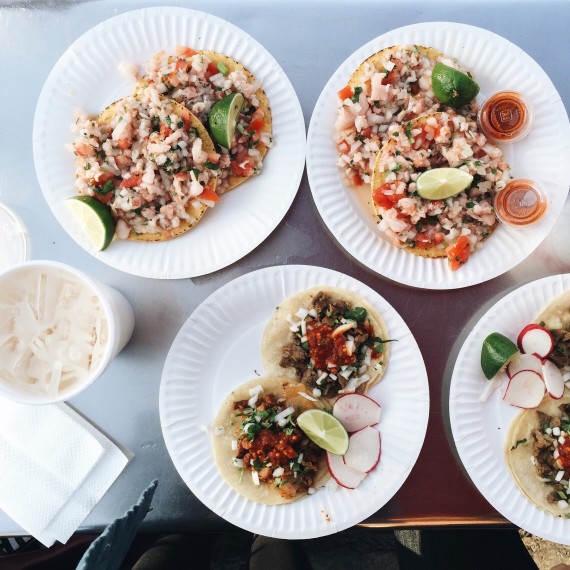
This means their daily starting food cost and the food they thaw, prep, or par-cook is very low. It also means their food waste is very, very low. Even if nobody buys a single specialty enchilada plate all week, they throw nothing away as those ingredients went into another menu item.
But this doesn’t mean you can only sell foods with a narrow range of ingredients and be boring. Don’t worry, your Chef prowess is not being challenged!
We’re saying consider each venue individually and how you can use a limited number of items to create a wide variety of menu delights.
Let’s say you’re selling grilled chicken, chicken sandwiches, and chicken nugget meals. That’s good menu planning. You decide to add a salad due to customer demand, but instead of selling a chicken salad, you offer a steak salad.
You’re now buying steaks, cooking them, and holding them without any knowledge of how many steak salads you’re going to sell. This is a recipe for food waste on a high cost item! If you had stuck with chicken salad, you could use that meat in one of your other dishes without waste if there wasn’t a high demand for salads at that show.
This seems silly but it’s actually very common. Chefs will add a random fish dish to their menu of steaks and beef. Or worst of all, have pulled pork sandwiches, steak fajitas, a catfish po’boy, and chicken thighs with eight different sides.

Not only is this a disjointed menu without a clear brand, it’s food cost suicide: you’re buying initially, holding, thawing, and par-cooking steak, pork, chicken, catfish, and all the sides and other ingredients that go into it.
If you sell it all, you got lucky. But more commonly, you won’t sell it all. And you don’t have any other menu items you can put the lower selling meats into. Because they’re already par-cooked, they can’t be kept very long, so you have to give them away or throw them away. This leads to high waste and expense as meat typically is your highest food cost.
(This is also why this secret is for the vending market and not catering. You’re pre-paid for catering and you don’t pay the food waste from uneaten foods so your menu can be as wild as your customer envisions. Someone will take the left-overs home.)
These wildly varied menus might work in a big brick-and-mortar restaurant with a walk-in cooler, walk-in freezer, and 50’ of dedicated temperature holding equipment. Add to that a long track record of daily and seasonal sales to accurately predict daily sales. But in street vending and concessions, it’s a recipe for financial disaster.
So, sell catfish po’boys, catfish baskets, and fried fish sticks for the kids. Add 2-3 cooked sides, and pre-packaged chips and a drink and get a premium price for the meal deal.
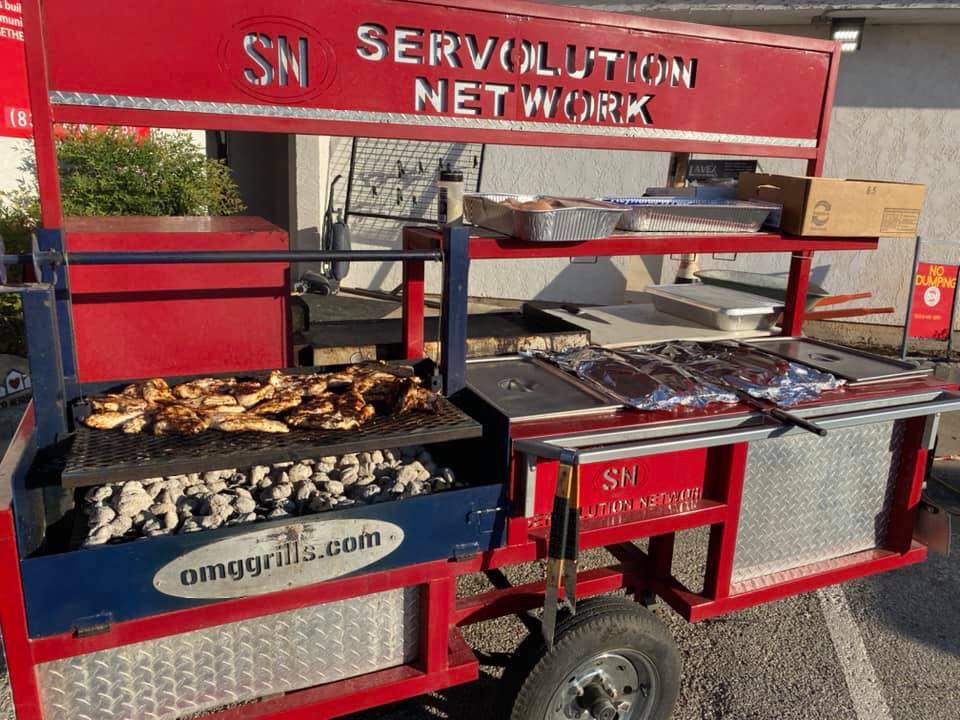
Then, if you want a change at the next event, serve a menu of pulled pork and BBQ. It’s fine to be diverse, just not all at once!
Speaking about selling catfish and BBQ, and despite everything we just said about having a controlled menu, a flexible menu is also extremely important.
This secret works no matter what menu you serve or how many types of food you cook.
Here’s the secret: Create different levels of menu complexity (and therefore pricing) that vary depending on the type of event.
One OMG weiner vendor practices this by having three menu levels he can choose from:
He decides which menu to use based on where he’s selling. For street vending, he usually uses the first tier, selling cheap dogs to construction workers and passers by. Same for local little league sporting events. At these, he’s using his OMG as a simple hot dog cart and charges a few dollars accordingly.
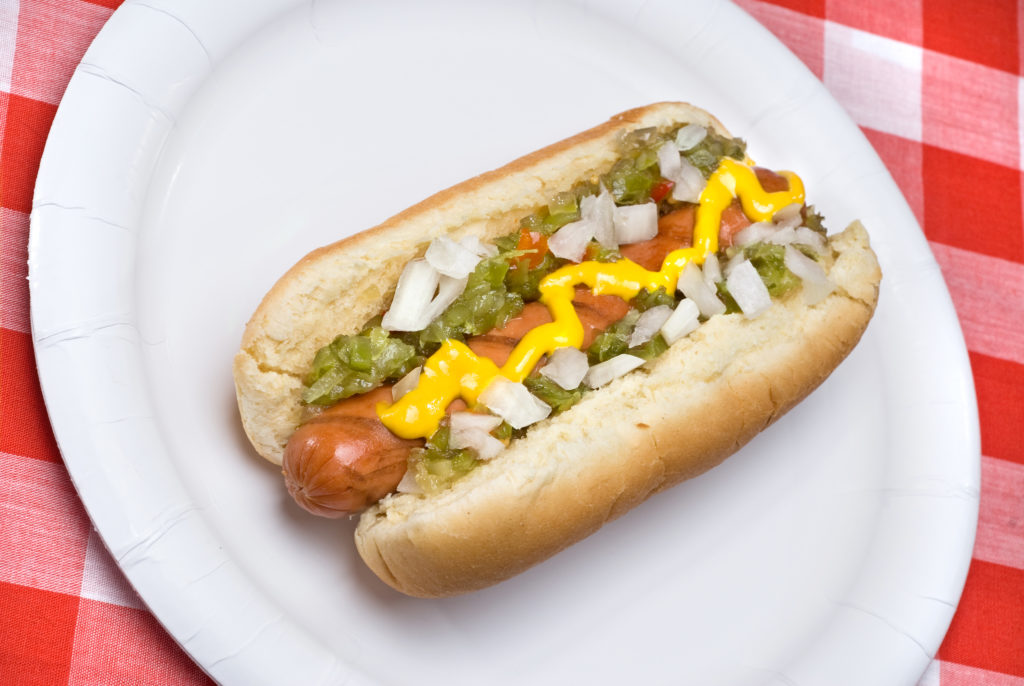
For smaller festivals and fairs, as well as larger local events such as church events, he uses the second tier. He charges $4-6 and sells lots of chili dogs. Now, he’s operating his OMG as a concession trailer. He also runs a healthy catering business at this tier for smaller fundraisers.
For big ticketed festivals and larger fairs and festivals (and of course Oktoberfest), his OMG is now a fantastic weiner cart with speciality bratwurst, sausages, and toppings, chili dogs and bowls of chili, cooked and prepared sides sides, plates/boxes with drinks and dessert, and kids meals with simple dogs.

He’s a full-blown competitor to the $100,000 food trucks and restaurants and is charging $8-12 for meals, and turning quite a profit as you’ll notice he’s also using the first two SPIFF secrets.
On the third tier, he also runs a full catering business for businesses, governments, and fundraising, and even does a few weddings a year at $10-20+ per person, many of which met him at these events.
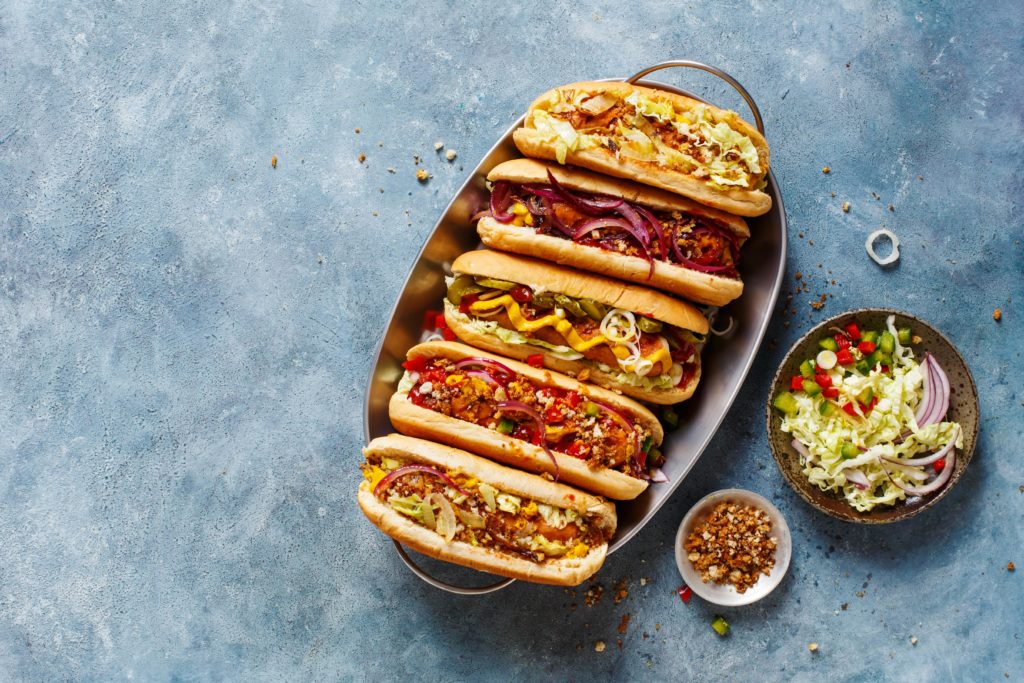
This is one trailer, one core menu, and one concept, but he’s flexing his menu to the event and charging $2-$30 per plate!
You can do this for any menu. From cheap, pre-wrapped BBQ sandwiches at local shindigs to quality pulled pork with sides at ticketed events to gourmet BBQ for weddings, you can flex your menu to where you’re selling to maximize your range of events and profit without changing your concept every time. And if you want to work three different concepts (one venue at a time), have three different tiered menus!
Note: Again, this is one is for the concession sellers and street vendors, and is less of a concern for catering where headcount and the specific menu is known.
Frozen foods are often made to be the enemy of quality cooking. And in some cases, this can be true. But it’s also often not the case.
Think about two key examples where frozen is often preferred: french fries (fresh fries are often extremely limp, crispy fries are frozen fries) and many types of fish, which is often flash-frozen on the boat!
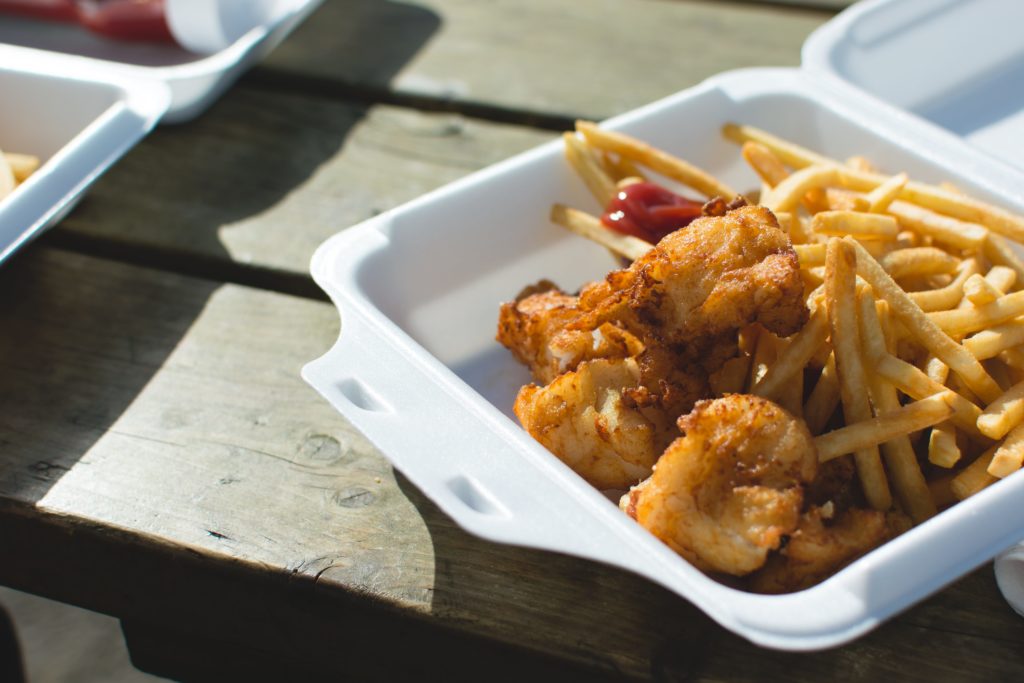
Focusing on the flavor is a very good thing. But pre-cooked or par-cooked frozen foods can be a huge advantage in controlling food costs and delivering a consistent flavor in foods, especially if you have a freezer at hand. (For example, our Texan and Eli Editions are fully loaded concession trailers with freezers and the full battery banks/inverters.)
You can freeze food yourself. If you have a specific recipe for freezable foods, cooking them in a commissary kitchen and freezing them until the show or event can be a great way to control food waste and standardize the flavor, no matter who is cooking at the show.
You can also buy pre-frozen partially cooked or raw foods from wholesalers such as Costco, Sam’s Club, and food suppliers, and then seasoning and finishing to-taste on the trailer.
There’s three key advantages to this.
First, consistency and streamlining food prep. This is especially true for pre-cooked or par-cooked foods, no matter if you par-cooked them or you bought them from a commercial commissary kitchen.
Consistency is key in building long-term customers, and if you’re not wanting to be the only chef behind the line, you’ll need to build consistent recipes and processes.
Using frozen foods greatly helps you do this, and these days is basically standard in chain restaurants to standardize menus and reduce wait time from when food is ordered.
Second, permitting. Let’s briefly talk health inspections. When selling concessions at events and street vending, a primary concern of the health department is going to be temperature control. We see the health inspector coming and we know the first thing that person is going to do is pull out a thermometer.
A frozen food is frozen. It’s not subject to precise temperatures hot or cold, as long as it’s frozen. And having your food for later held in a completely safe temperature zone enables you to use your other temperature control zones (like your steam table or warming box) for your ready-to-serve or mostly cooked foods.
And lastly, and perhaps more importantly, is food waste control. Again, frozen food is frozen. It’s not going to go to waste by the end of the day being held in the freezer, and it will still be ready to finish cooking tomorrow. Or the next day. Or next week.
You can learn more about frozen foods (and rehydration) in our video:
Whew, that was a lot!
But now you know how to have SPIFFy menu! (If you want to learn even more secrets for a super-profitable menu, comment and let us know.)
Let’s summarize the SPIFF quickly and put it all together.
Sell your food for maximum profit-per-person by upselling, combo-ing, and building menu items in a way that leads to a higher average ticket. And as always in the food business: drinks, sides, and desserts are high-margin and easy to make a combo offering with.
Price at top-dollar for your market (from the cheapest dogs to most expensive steaks). If you can sell something for $2 there’s no reason to sell it for $1.50 and potentially leave thousands of dollars on the table over the course of a few shows.
Ingredient crossover for minimum food waste (and cost) by building a menu as large and complex as you’d like, but with as many of the same ingredients as possible. Remember the Mexican restaurant example as you’re building your menu and ask yourself, how many things can I cook with this ingredient?
Flexible menu design will help you be successful in as many shows as possible and make the most profit from those shows. Think of a simple, cheap version of your menu with few ingredients, a “standard” version with more menu items and sides, and fancy version with all the trimmings, especially for use in catering and high-cost ticketed events.
Frozen foods are not the enemy. It’s good to maximize flavor, but think about the temperatures food needs to be stored at and how long it’ll last like that. If it’s frozen, it’s not an issue for your wallet or the health department.
Now you’ve got your costs controlled and the perfect menu. Let’s dive straight into the next secret to grow your revenue.
We often think of concession trailers exclusively selling concessions: at fairs, local events, festivals, and the like. But here’s a not-so-secret secret in the concessions, vending, and food truck business: catering is king if you want cash.
We’ll get into that in a moment, but first I’ll tell you the secret: your festivals, events, and street vending is basically a giant advertisement and paid tasting session for your catering business.

Basically, you can pay to advertise your catering business and try to talk people into believing your food is great. Or you can get paid to advertise your catering business by having people pay to try your food and find it delicious.
This is why restaurants can do so well in catering. The restaurant is the advertising vehicle for their catering; their menu is the taste test. But you can do the same thing with your events and street vending (and then the catering gigs themselves continue to be more paid advertisements for more catering).
Specifically, the catering you’ll be doing in January when there’s few events going on or the wedding catering in the summer where you can charge $25+ a head (instead of $12 at a festival, where that extra $13 each is pure guaranteed profit).
I know some of you think your concession trailer is only for concessions or that your menu isn’t classy enough (remember menu flexibility?). But there’s so many reasons for catering that it’s an article and video coming up all on its own (subscribe for updates!).
But in summary, the advantages of food trailer catering are:
Basically, instead of paying for a place to sell and taking all of the risk on food waste, weather, and turnout, you get paid to be at a place and carry none of the risk. Also you get paid more for the food itself (often a lot more, especially for weddings) and often reimbursed for other expenses such as travel there.
Catering is also a huge business, bringing in an astonishing $58 billion dollars a year in the US alone, not including staffing and other fees, and continues to grow year-over-year. And that number is from 2017, with multiple years of substantial growth since.
It’s also incredibly broad: we often think of catering for weddings and big parties, but the corporate and business catering market is also large. Many companies and charities of all sizes have regular catered events, meetings, promotions, and more. After all, they have employees and customers who eat at least once a day in or around their offices.
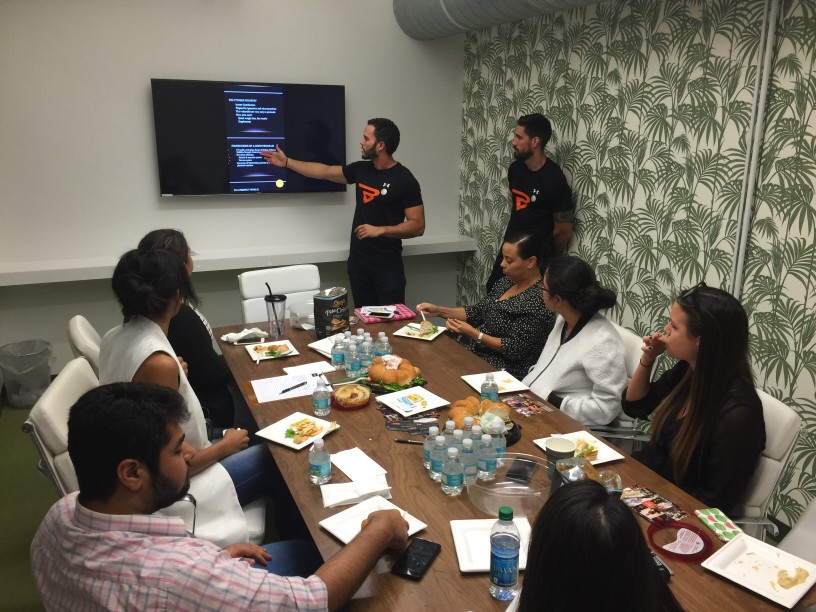
Sounds amazing, right?
Why not just cater? Why bother with events or street food?
Well...we’re not exactly the first people to realize catering is a great deal. There’s lots of competition in catering, especially since it seems every chain restaurant has jumped on the trend.
But the food truck and trailer catering business is its own specific niche, and one that many people like to schedule for personal events. These customers are specifically searching for a fun food truck or trailer to cater their parties, which knocks out those big chains and a lot of the kitchen-only catering competition.
If it’s an outdoor event, food trailers have a natural advantage over table-only catering, as you’re accustomed to working outside, unlike conventional catering companies or restaurants.
You can also cook on-site for large crowds or do private chef-style cooked-to-order catering, something kitchen-only catering (like from restaurants) can’t do. Really, the creative possibilities in catering are endless.
But that’s often not enough, because there’s also a great deal of competition in the food truck and trailer catering market. Now, if you’re in a smaller city, this is a much simpler challenge to overcome as there won’t be anywhere near as many food trucks or trailers operating.
So let’s get back to the secret on overcoming this: your street vending, fairs, festivals, and so on. If you’ve got great food (which I know you do), the best moment to sell someone your catering is while they’re eating it, looking you in the eye, and looking at your awesome setup. That’s your sales opportunity, and best of all, they paid you for it!
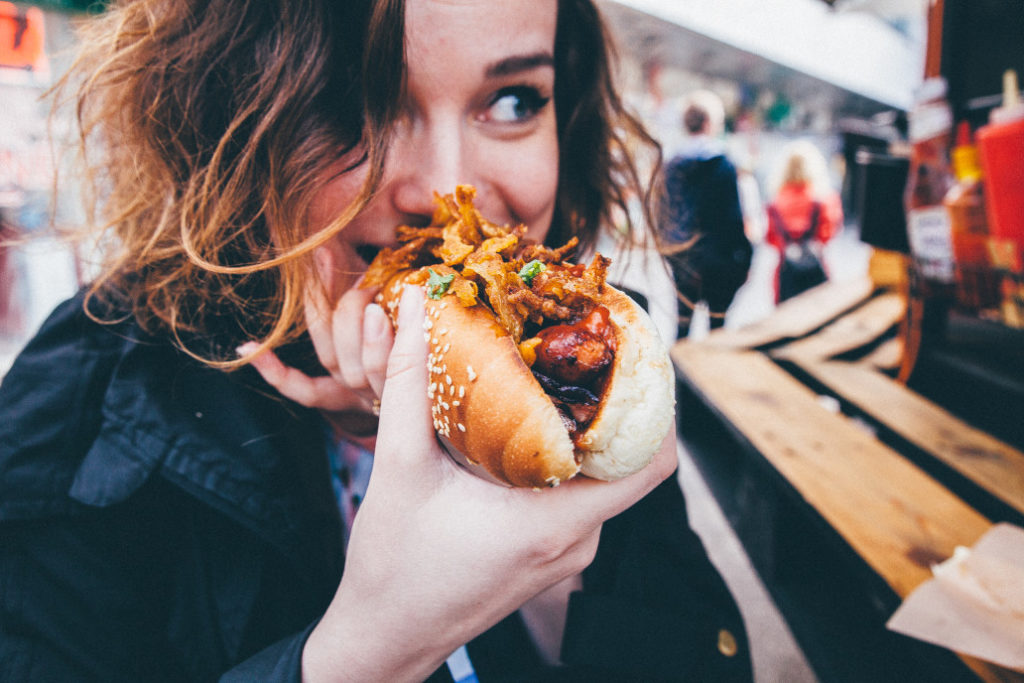
Think of your street vending and events as catering demos you get paid to give, then think about ways to present your catering on-site.
Have catering fliers, cards, your website’s catering page, on receipts, catering signage: make sure everyone who buys from you knows you offer your amazing food for catering.
Put out a sign with your social media handles, and set out a book (or a tethered-tablet for the fancy) to collect email addresses to get discounts, specials, and location updates. MailChimp has a generous free plan to manage and send your promotional emails.
When winter comes, you can now market your catering to those emails.
We’ve got more to say on being just as profitable during winter in Secret #5, no matter how cold a climate you live in, but first let’s talk about another way to boost your revenue: booking more profitable events.
It’s not a secret that not all events (and catering gigs) are created equal. Some are simply much more profitable than others because they have a track record of higher attendance. But the best events and gigs are often unsurprisingly the hardest to get into as show coordinators tend to favor repeat vendors year after year.
But here’s the secret: have a menu and brand concept that makes you stand out. More specifically, that makes you stand out on a written application, which is how you apply to new events.
When event organizers are looking at their applications, they get many of the usuals: average burgers, basic BBQ, and so on. They may also have vendors in those spaces who have been vending a long time at that event who get priority treatment or better spaces at the show.
When you’re just getting started, people don’t know how great your food is yet. You need a chance to get in front of the best crowds (remember secret #3 on why this is important to build your catering business).
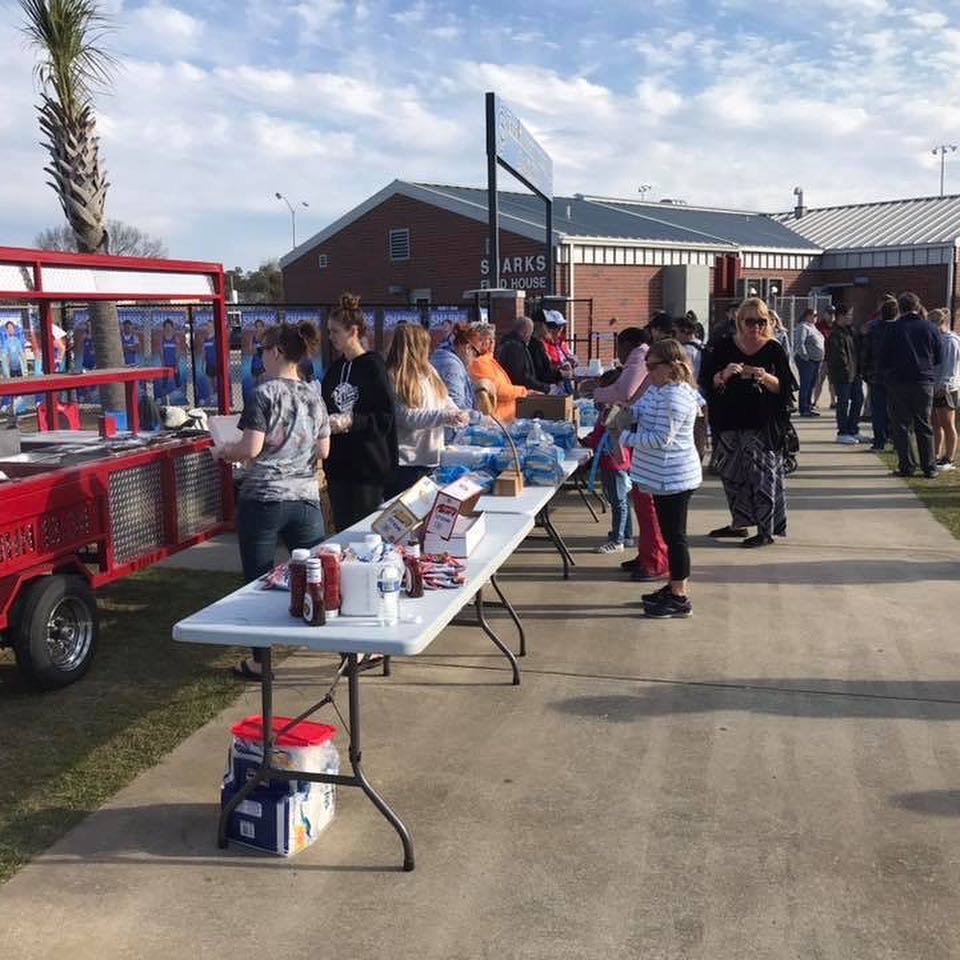
And when it comes to really leveraging secret #3 and using your events and vending as the ultimate catering advertisement, you need to be memorable. You need to be something they’re excited to come and pay to cater their event: you specifically. It takes time to build a reputation in food quality. And in the meantime, you have a business to run.
For now, you need something to differentiate you from the others. You may already know what makes you unique, and if you’re planning on using an OMG, the trailer itself will differentiate you. (Especially if you turn on the LED lighting of your logo or name of the roof of the Eli Edition.)
But one easy hack to stand out is to give a thematic twist to your menu.
Sell burgers? You’re a Chuck Wagon.
Sell BBQ? You’re the Smoke Master.
Sell authentic Mexican? You’re Aztec Concessions.
Sell catfish? You’re Bayou Delights.
We’ve seen two of these recently. A “Hawaiian Chicken” trailer had workers dressed in Hawaiian floral shirts serving roasted chicken and roasted pineapple to keep on theme. It's a chicken trailer. But the Hawaiian shtick makes it stand out.
Another example, the Twister trailer primarily served BBQ sandwiches but featured a Tornado Potato, which was a spiral cut deep-fried potato. So, it's a BBQ trailer with a side of potatoes. But their unique potato style and accompanying branding make them memorable.
In both cases, the “Hawaiian” and “Twister” were temporary signage, banners that were mounted on the tent over or around the trailer.
Due to all the fanfare and uniqueness, they had massive lines and prominent spots in the shows. They also run large catering businesses, as individuals and businesses want them to bring their fun trailers and concepts to spice up their events.

I’ve seen setups with multiple shticks, transitioning from sports-themed to standard to local without missing a beat, and using their concepts to get them into the best shows, be memorable, and book more jobs, all while building their mobile culinary reputation.
It’s something to think about as you plan your concept. But as you’re building your business plan, you should also keep in mind...
It’s no secret that the concessions and street food markets take a drop in sales during the most frigid months, as less customers are willing to stand in the cold to order and eat, and there are fewer outdoor events.
This is true with any concession or outdoor selling style, which is part of why you don’t want your fixed overhead to include a payment on a $30k concession trailer or $100k food truck without a plan to cover it. (Remember secret #1 on controlling overhead being a financial priority.)
Of course, this sales drop is felt less in warmer climates where winter is shorter and milder. But this doesn’t need to be a huge issue for folks living further north, and with the proper planning and preparation, you can continue your summer success into winter.
The secret is to build multiple streams of income from your concession trailer, preferably before Jack Frost comes to visit
The first and most obvious revenue stream is what we already discussed earlier in this guide: build your catering business. Thanksgiving and Christmas are some of the heaviest corporate, business, charity, fundraising, and personal party catering seasons, and you can leverage your existing catering efforts from the show season.

This is also why the catering email building and social media strategy is important, as you won’t have as many shows to use as catering advertisements. You can now send out emails and post to social media with catering specials, menu ideas, photos of events you can take with your phone, and more to stimulate catering bookings.
There are many more clever streams of income you can build with a food trailer.
We’ve seen OMGs used for such winter activities as:
(If you want us to publish a mega list with details of different extra income ideas we’ve seen successfully cooked up on concession trailers and OMGs, leave us a comment and we’ll bump it up on the list.)
Building seasonal versions of your catering menu and putting out signs, photos, and fliers at late fall shows (Oktoberfest, corn mazes and pumpkin patch events, and fall festivals) can also help drive winter catering revenue.
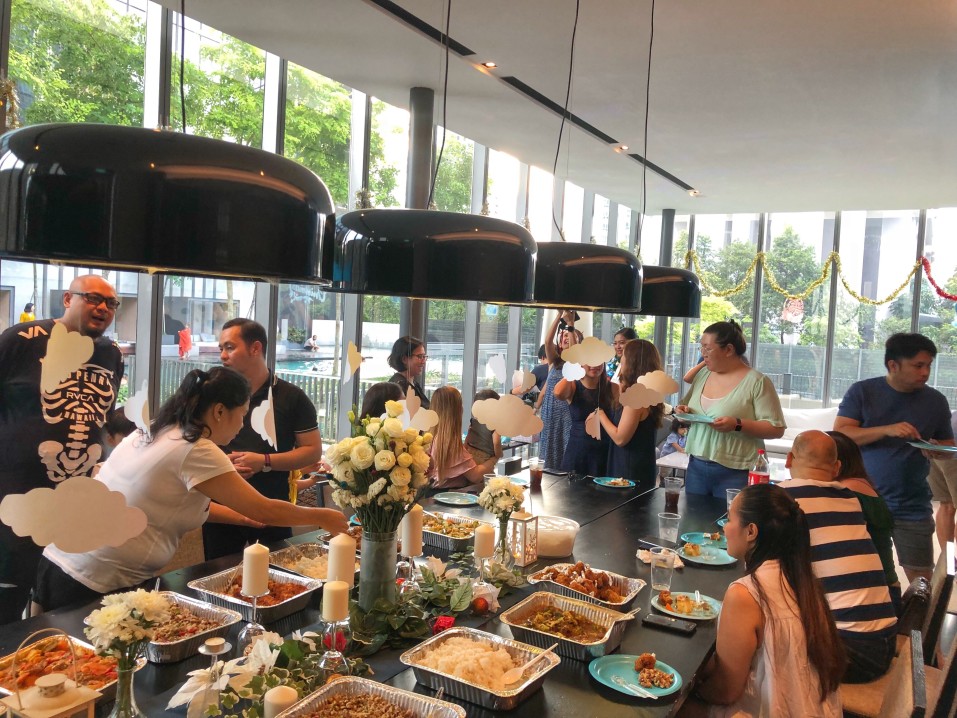
At this point, the catering you do will become the catalyst for even more catering. Make sure to be available and keep fliers and cards on hand at events you cater, as they become your primary paid taste testings for the winter.
Well, that’s the last secret. If you do the above, you’ll be far ahead of the competition and have everything you need to build a successful company. We’ve got some detailed resources and workbook materials to help you put it into practice.
But first…
This last one is going to be a bit more sales-y, which is why it’s a bonus secret. But it’s also very honest and we’re 100% confident that using an OMG can help you leverage everything we talked about above better than a conventional enclosed concession trailer or a $50,000+ food truck.
Let’s talk about how an OMG can help you to control your costs, starting with drastically reducing overhead. Obviously, moving from a $25,000 trailer or a $50,000 truck to a less-than-$10,000 OMG model is going to be a lot cheaper; and you still get a complete mobile kitchen!
But we can help in other ways to get you into business as soon as possible! We offer a rent-to-own no-credit check program and we work with multiple financing providers.
The payment on even the most expensive OMG - the Eli Edition - is going to be drastically less than other trailers or trucks. And even then, the Eli Edition is a true fully loaded concession trailer with professional equipment: commercial four-compartment sink, battery-based power supply, a covering, commercial griddle, lava-rock gas grill, commercial deep fryer, smoker/warming box, and more.
AND it’s built from the ground up just for you, and in the color that matches your branding.
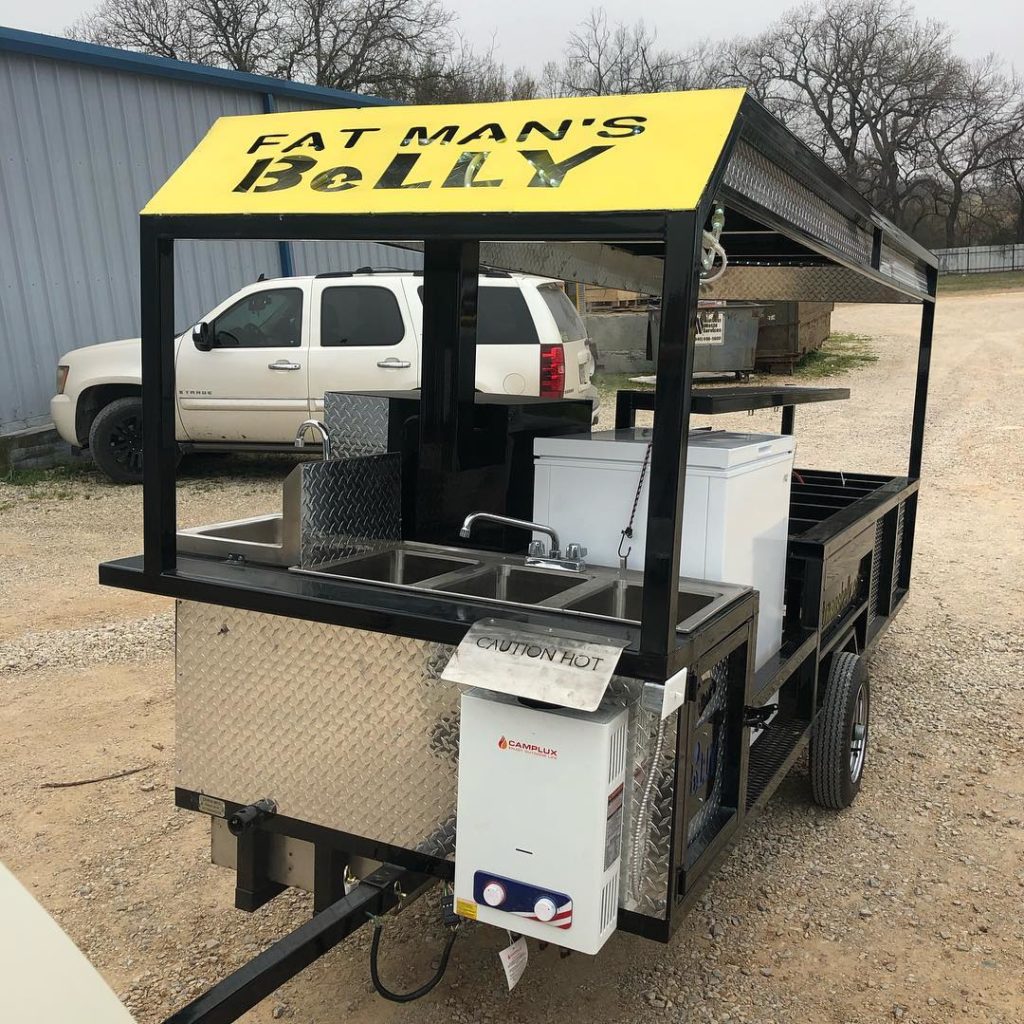
On the subject of equipment, OMGs cooking lines are designed to allow for flexible menus, excellent hot and cold storage, and highly efficient, fully equipped, and easy to work on. The open design lets you pass food from the cooking side to the serving side without taking a step, and the steam table and ice wells hold food for easy buffet-style serving for catering or plating for concessions.
And if you need a specialty line, we’d be happy to build a custom OMG for your exact menu configuration.
How is that possible? It’s due to our unique, open, patented design. Most trailers cost so much because of how they’re built, and provide a sub-par experience when it comes to differentiation, connection, and flow of food.
Not only are our open trailer designs drastically more affordable, we believe this design can lead to more sales. After all, open kitchens are all the rage in brick and mortar restaurant design. Why not mobile open kitchens? We have our over 700 OMGS in operation to prove they are a hit.

We know there are some who think only a closed truck is the way to go. But the common reasons leveraged against open kitchen trailer concepts just don’t make sense.
Let’s start with the obvious: permitting. This is a common misconception but don’t be mislead: an OMG can permit the same as a concession truck. If the health department is going to force you to use a local commissary kitchen for prep on an Eli Edition, they’re going to do the same thing for an expensive food truck.
The reality is some counties and cities play nice with mobile kitchens and some don’t, and if need be, we’ll work directly with your health department to make sure you can permit the same as any food truck.
Here's a quick video on permitting:
Now, let’s talk weather.
Open and enclosed models don’t have a real difference in serving customers: if it’s so cold or raining so hard you can’t bear to be outside cooking on an OMG, your customers aren’t going to want to stand in line in a blizzard or eat in a downpour. Having a food truck doesn’t fix those circumstances; you’re just making a much larger payment for the same lack of customers.
Better yet, OMGs can go inside. Seriously, you can hand maneuver any OMG - including our largest model the Eli Edition - through double doors and into a mall, office, store, or other indoor location. We have customers who are paid to bring their OMGs into grocery stores to do live cooking demonstrations!
This opens up winter-time catering opportunities in a unique way. You can cook or finish par-cooked foods on-site, hold foods at the right temperature, and even serve buffet-style right off the steam table...complete with utensil dispenser, counter space, and a rear cold drink tray.
An open kitchen on a highly affordable OMG Grills concession trailer let’s you:
Let’s wrap up with a quick summary.
[Secret #1] Understand the different types of expenses and control them well, putting particular emphasis on controlling your unavoidable monthly expenses (overhead) and recurring expenses like food cost that bleed money, while not shrinking away from high-return business building single expenses.
[Secret #2] Use the SPIFF method for the perfect + profitable menu. To re-cap the SPIFF method again:
Sell your food for maximum profit-per-person by upselling, combo-ing, and building menu items in a way that leads to a higher average ticket. And as always in the food business: drinks, sides, and desserts are high-margin and easy to make a combo offering with.
Price at top-dollar for your market (from the cheapest dogs to most expensive steaks). If you can sell something for $2 there’s no reason to sell it for $1.50 and potentially leave thousands of dollars on the table over the course of a few shows.
Ingredient crossover for minimum food waste (and cost) by building a menu as large and complex as you’d like, but with as many of the same ingredients as possible. Remember the Mexican restaurant example as you’re building your menu and ask yourself, how many things can I cook with this ingredient?
Flexible menu design will help you be successful in as many shows as possible and make the most profit from those shows. Think of a simple, cheap version of your menu with few ingredients, a standard version with more menu items and sides, and a fancy version with all the trimmings, especially for use in catering and high-cost ticketed events.
Frozen foods are not the enemy. It’s good to maximize flavor, but think about the temperatures food needs to be stored at and how long it’ll last like that. If it’s frozen, it’s not an issue for your wallet or the health department.
[Secret #3] Leverage your street vending, fairs, and festivals to drive extra revenue by using events as paid advertising and taste testing for your catering business.
[Secret #4] Build your brand in a way that gets you into the best events by differentiating your concept.
[Secret #5] Build for the winter in the summer by generating multiple revenue streams due to different styles of vending, collect contact information, and build a reputation for year-round catering opportunities.
An OMG is an excellent tool for all of those things. It’s affordable to reduce your overhead, helps you build a tight menu to control costs, can be used for any show or catering opportunity inside or outside, and differentiates you right from the start.
Ready to get started? If you’re ready to start looking, you can check out our flagship Eli Edition or browse through our entire lineup.
If you're still working on your concept, fill this out and we’re happy to help you develop your concept, talk about your menu and flow of food, or just chat about the concessions business.
We hope this guide has been helpful and we’ve got more on the way.
Happy vending from Tabatha, Tim, and the OMG Grills family.
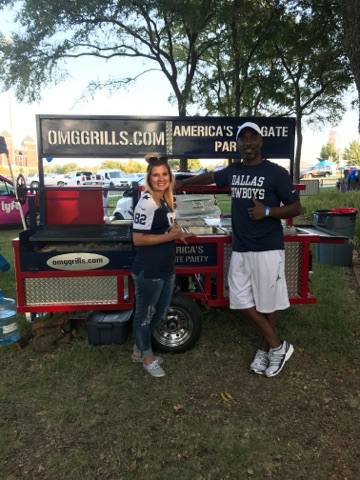
Speed, consistency, and cost savings: all critical components of running successful concession trailers.
Today we've got a new video talking about a trend in mobile vending: using commissary prepared foods. Using pre-cooked foods that are thawed, re-hydrated, seasoned, and finished on-site is a cheap and easy way to build a business in food vending.
Check it out here or on YouTube:
Comissary-cooked or not, we'd love to talk about your menu and how an open food concept concession trailer could work for you. Give us a call at 817-382-2728 or click here to Talk to Tabatha about your food trailer concept.
How do our unique open-design concession trailers permit? Does an OMG pass health inspections? These are questions we get all the time, so we've put together this post and video to clear things up.
The simple answer is yes: OMGs can permit as concession trailers, food trailers, catering trailers, food carts, and many types of commercial permits. There are hundreds of OMGs operating with commercial food licenses across the united states every day.
The exact process varies greatly by state, city, and county so it's tough to go into a ton of detail on why and how. In any case, since our trailers are custom built to order, we're always happy to work with you to modify your OMG to work with your local health department.
We filmed a quick fireside chat with Tabatha with more details on health department inspections:
One important thing to understand it that inspections will vary on the type of food you're selling. Commisary-style foods will effectively always permit, even in counties turning down $200,000 food trucks for food handling licenses. For other types of food prepared on-site, it's going to depend on the temperature requirements of that type of food and sanitary regulations for that county.
Thankfully, OMGs are designed specifically for excellent temperature control: from the high BTU output steam tables to insulated smokers to griddles and grills we've got hot food handled. Every OMG either comes with a stainless steel four-compartment sink and drainable steel ice chest standard or can have one or both added. And we have multiple models with freezers/fridges and the on-board battery system to power them.
If you're looking for an all-in-one package, our signature Eli Edition takes the open food trailer and grill trailer concept to the next level into a full-blown commercial mobile kitchen, with a pressurized stainless instant hot water three-compartment sink, separate hand-washing sink, and the fresh and grey water tanks to power them. As well as a built-in drainable ice chest, a vented cover, five-well steam table, smoker or insulated holding box, Blackstone large griddle, lava-rock grill, LED lighting to serve anytime, and freezer/fridge. Fully powered off-the-grid with propane and a battery bank and charge inverter.
If you have any other questions about health inspections, talk to your local health department or give us a call. And don't worry about it, we'll work with you through the process!
We're thrilled to announce our new partners for financing your OMG concession trailer. We have five featured companies who offer different loan types: business loans, personal loans, and equipment loans. Some offer programs for bad credit, bankruptcy, and startups without business history. They all have different qualification requirements.
Before we go any further, we need to mention that this isn't financial advice, but general info on different options. We're not financial planners and you should always consult qualified counsel before making major purchases.
Now let's get started making your dream a reality.
Absolutely not! Anyone can utilize our in-house rent-to-own program with no credit check and only 10% down. Have no fear, that program isn't going anywhere.
However, there are two key differences between financing and our rent-to-own program:
With our in-house lease-to-own program, you get your trailer when 50% of the balance is paid. After putting 10% down, your monthly payment is paid in equal payments for the next 12 months.
If you need your trailer immediately (say for a specific event you're already booked for) and can't or don't wish to pay in full, working with one of our financing partners provides a solution. Because the loan duration can be longer, your monthly payment may be lower (as the remaining balance is spread out over more months).
We feel it's important to offer these various financing solutions as your situation is unique to your life and so it's up to you to decide what's best for you.
Let's take a look at the financing partners.
Great for startups and established companies looking for low down-payments
Our newest financing partner, Archer Capital provides financing options with flexible programs, including 100% financing with only first-and-last month payments.
From their Leasing page:
Financing with Archer Capital allows you to purchase the commercial equipment you need today while spreading your payments over a set time frame. In addition, because a lease is not considered a long-term debt or liability, it does not appear as debt on your balance sheets or credit report.
It's a commercial equipment lease and therefore a business transaction, but they accept startups and promise to work with you on credit, as well as consider creative financing arrangements like income statement financing.
Since it's an equipment lease, they pay us directly for the trailer. For more information, a loan calculator, and to apply, visit the Archer Capital website.
Great for startups or those with less-than-ideal credit
A newer player in the small businesses financing space, Quickspark facilitates equipment loans, of which your OMG food trailer is.
As the Quickspark about page states:
We work with multiple funding sources which help us find the most competitive rates. Not everyone has the same circumstance, we get it. Bankruptcy? Startup? Derogatory credit? We can help! By working together, we will find the perfect plan for each individual need. We promise.
This is a business loan, but they accept startups and more mature businesses with a variety of credit situations: good credit, derogatory credit, bankruptcies, and in-between. They usually have small payments, and the interest rates vary depending on credit.
Since it's an equipment loan, they pay us directly for the trailer. For more information and to apply, visit the Quickspark website.
Great for established businesses or those with less-than-ideal credit
This is an equipment business loan targeting more mature businesses, preferring 2+ years of business credit history, in which case they will primarily offer business credit.
If you're a newer business, they will use your personal credit, with a minimum requirement of only 625+. The loan terms vary from 12 to 60 months and the interest is based on credit history.
As it's an equipment loan, they will pay us directly for your trailer. For more information and to apply, visit the Innovative Lease Services website.
Great for: OMGs for non-commercial purposes
If a business loan isn't for you, you could alternatively use a personal loan. Others have had success with this lender in the past.
Lightstream is a personal loan provider and a division of SunTrust bank. They allow bad credit, and the interest rate will vary based on your past credit history.
Since it's a personal loan, they pay you and then you'll order the trailer from us and pay with the funding. One benefit is they provide loans for up to 144 months, which could result in a lower payment, depending on the interest rate.
Lightstream has a convenient calculator on its homepage for personal loans, and you'll need to apply directly.
Great for established companies with 2+ years business credit history
This is a business loan for more mature companies, preferring 2+ years in business credit history with a minimum score of only 625+.
They only provide business loans, and since it's an equipment loan, they'll pay us directly for your trailer.
On the financing page of their website, they state they provide:
Interest rates and loan terms vary by credit history. For more information and to apply, visit the American Capital website.
Great for established companies or startups with better personal credit
This is a business equipment loan provider who works with start-ups if they have a 700+ credit score and put 20% down. For established companies, only a 680+ credit score is needed.
On their business loan page, they state:
Navitas helps business owners protect their capital, overcome limited budgets, and procure the equipment their company needs to keep growing at the same time. Our equipment lease and loan financing programs provide you with the ability to acquire state of the art equipment, software and services with affordable financing programs that can be customized to meet almost any budgeting need. Equipment leases or loans…our Navitas Financing Specialists will build a solution that is the perfect financing fit for your business.
This is a business loan for equipment, so they'll pay us directly. They provide loan terms from 36 to 60 months. Interest rates vary depending on credit history.
For more information and to apply, visit the Navitas website.
(If you're looking for Rock Solid Funding from prior promotions, we're sad to say we no longer are partners. Consider one of our other options on this page or use our rent-to-own program as an alternative.)
We recommend reviewing the above options, talking with their loan officers, and seriously considering this financial decision.
When you're ready, use the applications linked above as these financing companies already have our Erwin Manufacturing information and are familiar with our OMGs.
And if you decide conventional financing isn't for you, there's always our rent-to-own program. The monthly payment may be higher, but it'll be paid off sooner and there's no credit check or qualification process -- everyone is approved!
And remember to consult a qualified professional for financial advice. After all, we're food trailer experts, not financial planners. But we'd love to chat with you about your menu and goals!